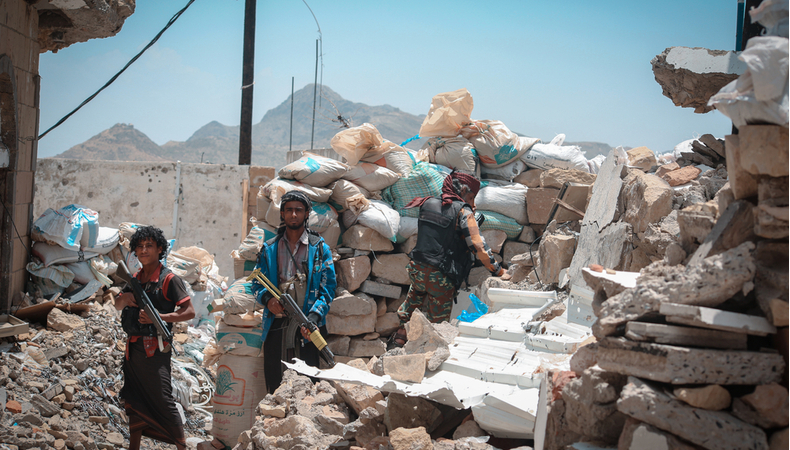A new Houthi attack kills at least 29 people in Yemen


The news was reported by local media, specifying that the Houthis fired a ballistic missile at the home of a leader of a local tribe, Sheikh Abdul Latif al-Qibli, located in the district of al-Juba, in southern Ma’ rib. According to eyewitnesses, the missile hit five homes, including that of al-Qibli, causing the destruction of several homes and 12 civilian victims. As stated by local sources, the toll is set to rise, and, at the moment, this would also include two sons of the sheik. Abdul Latif al-Qibli, who later specifies al-Jazeera, is considered one of the most eminent leaders in the Ma’rib governorate and is known for supporting pro-government Yemeni forces.
The attack was the second of its kind perpetrated in about 24 hours. In the district of al-Juba, the locality of Jerash was hit with about 20 mortar rounds and Katyusha missiles by the Houthi rebels a few days ago. “Dozens” of wounded were killed, while more than 500 families fled after witnessing the destruction of their homes. In this regard, also on October 27, a pro-government organization of Ma’rib, committed to the defense of human rights, reported that the continuing escalation had caused about 300 victims, including dead and wounded, in the district of al-Juba alone. At the same time, another 10,000 families were forced to displace.
Faced with this scenario, the Yemeni Information Minister, Moammar al-Eryani, in a Tweet on October 28, called on the international community to prosecute the Houthi fighters as “war criminals.” The same minister highlighted the ongoing bombings perpetrated by the Shiite group against villages and civilian homes in al-Juba employing ballistic missiles, drones, heavy and medium-caliber weapons, which forced hundreds of families to displace. The reason why, the international community, the United Nations, the permanent members of the Security Council, and the envoys of the UN and the United States have been urged to condemn and stop these “reprisals” which target innocent civilians and constitute, according to al-Eryani, war crimes and crimes against humanity.
Coinciding with the attacks by the Houthis, the fighting on the ground has not yet stopped. On the one hand, these involve the pro-government forces, supported by the international coalition and local tribes, and, on the other hand, the Houthi rebels, backed by Tehran. On October 27, the spokesman of the Yemeni army, Abdo Majali, stated that his soldiers continued to take control of several locations in the South of Ma’rib, destroying combat vehicles and military equipment belonging to Shiite fighters in the Murad, Harib, and al-Juba areas. In contrast, Saudi-led international coalition planes hit positions and ammunition depots.
The offensive against the governorate of Ma’rib was launched by the rebels last February. However, some believe that this region could be the key to resolving the wider civil conflict in Yemen. In addition to being the last stronghold of pro-government forces in Northern Yemen, Ma’rib represents a strategic region rich in oil resources, a gateway to Sana’a, allowing the rebels to consolidate the desired projects in northern Yemen partially. Moreover, some analysts say conquering Ma’rib could change the balance of power in a conflict going on for about seven years and allow Iran, a supporter of the Houthis, to weaken Riyadh’s influence in Yemen.
As reported by Al-Arabiya, quoting a commander of the pro-government forces, the region has turned into a “hotbed of attrition” for the Shiite group. So far, the Houthis havarliament-suspends-session-without-crisis-breakthrough/”>Libya: Parliament suspends session without crisis breakthrough

Israel strikes Syrian port of Latakia, massive damage at the area

Qatar-Turkey continue to remote control Syrian mercenaries as they aim for Afghanistan

Lebanese President Michel Aoun said that Lebanon needs ‘six to seven years’ to emerge from the crisis.

How the Iran nuclear deal is magnifying regional tensions
e created an “arch” that extends from Mudaghl and Raghwan in the north to the Sirwah district in the west, up to Rahba and Jabal Murad in the south. From which they launch attacks against the forces pro-government. However, the source said, the attacks were largely unsuccessful.
The Ma’rib offensive is part of the broader picture of the civil conflict, which began following the coup d’état of the Houthis on September 21, 2014. Since then, there have been, on the one hand, the Shiite rebels, supported by Tehran, and, on the other hand, the forces linked to the internationally recognized Yemeni government. Since March 26, 2015, the pro-government army has been assisted by an international coalition led by Saudi Arabia.
According to UNICEF, on October 19, four out of 5 children, equal to 11 million, needed humanitarian assistance, while according to the International Organization for Migration, 55,000 civilians have been forced to displace, in the period from the first January to September 3, 2021, in Ma’rib governorate only.




